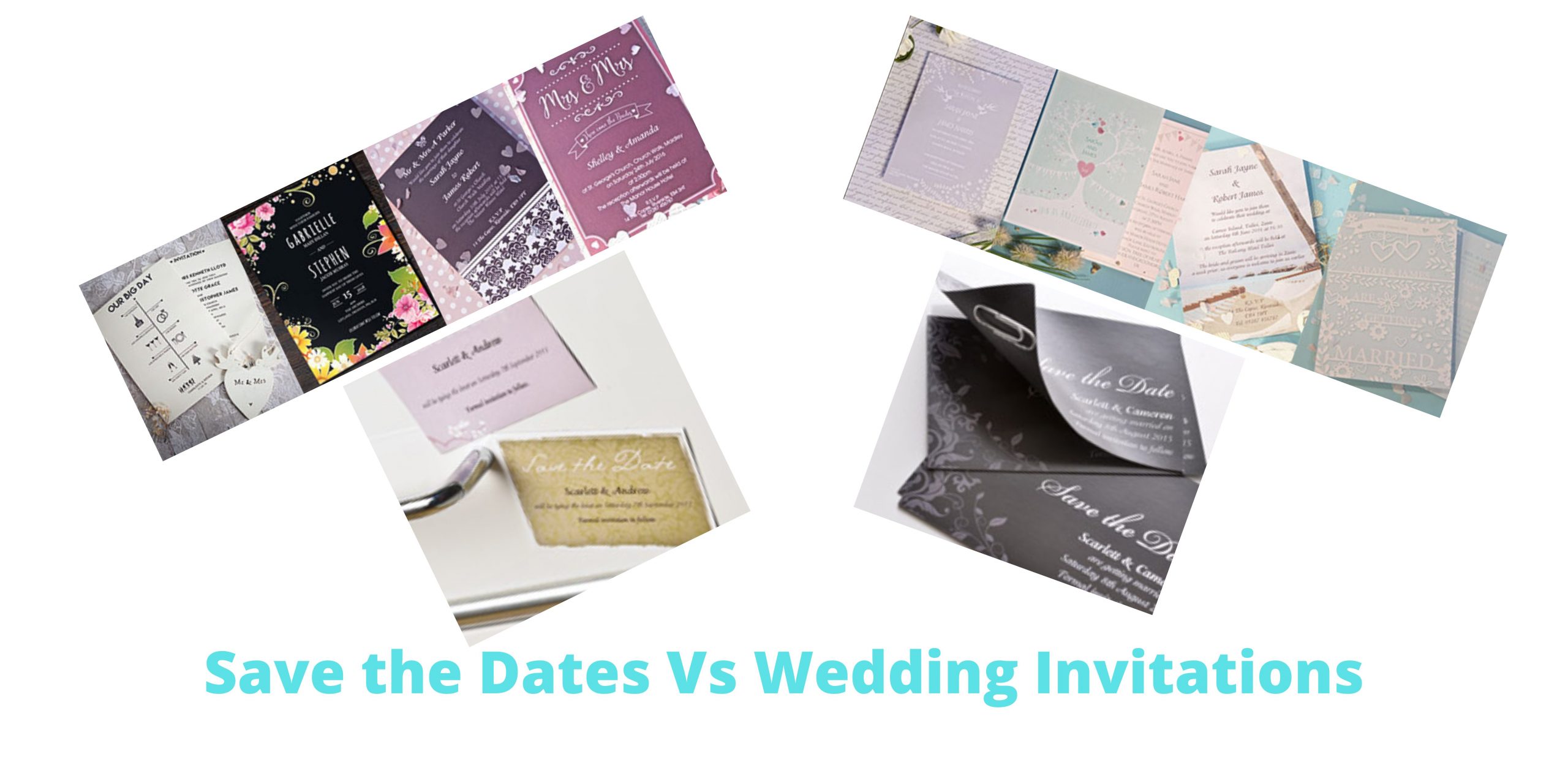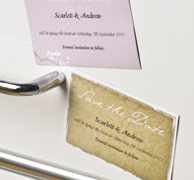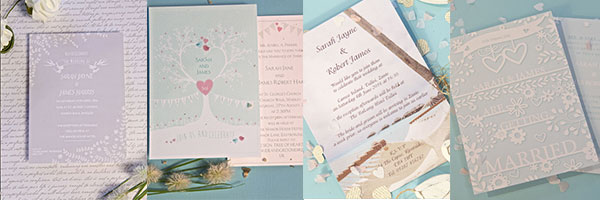If you’ve recently got engaged, you’re probably being hounded by friends and relatives asking you questions like “have you picked a date yet?” and “when are you going to send out save the dates?”
If you’ve not been invited to many weddings before, you’re probably wondering: what exactly is a “save the date”, and is it the same thing as a wedding invitation? Are they both necessary?
A save the date is a standalone (and very important) piece of wedding stationery which is completely separate to a wedding invitation. It’s sent out several months before the invitation, and its sole purpose is to inform your future wedding guests of the wedding date. It doesn’t contain any other details about your wedding day celebration, and it’s not meant to be replied to. Formal invitations are then sent out closer to the big day, along with a reply card.
This guide will further explain exactly what the difference is between a save the date and a wedding invitation, what information you should include on each, and whether you truly need to send out both.
What Is a Save the Date?
A wedding save the date is, essentially, like a formal “heads up” about your upcoming wedding. Its purpose is to act as an engagement announcement, and let your potential guests know when the wedding date will be. That’s it!
A save the date is not the same thing as an invitation (there’s no reply card, so the recipients aren’t expected to RSVP at this stage). However, anyone who receives a save the date should receive an invitation eventually. So, only send them out once you’ve decided exactly who you want to invite, and confirmed that the venue will be big enough to hold them all (if everyone says yes).
The purpose of a save the date is to inform your invitees of the wedding date well in advance, so that they can book time off work and avoid making any other arrangements on the day in question.
Once you’ve organised all the little details, such as what food you’ll be serving and what time the ceremony will start, then you can send out the formal invitations.
What Information Goes On a Save the Date?
A traditional wedding save the date contains the following information:
1) The names of who’s invited (usually on the outer envelope, not on the card itself)
2) The names of the couple getting married
3) The wedding date
You don’t need to include the wedding venue. However, if you’re tying the knot more than an hour away from where your invitees live, it’s a good idea to include the name of the town at least. This will give your invitees some forewarning that they’ll need to travel.
A save the date usually ends with “invitation to follow”, to let guests know to expect a formal invite later on.
How Far In Advance Do You Send Save the Dates?
Because the only purpose of a save the date is to spread word of your wedding date, you can send them out practically as early as you’d like. The only thing you need to do before sending save the dates is to book your venue. You don’t need to have finalised any other details.
Save the dates are usually sent out 4-6 months before the wedding. You can go earlier than this for destination weddings.
However, we wouldn’t recommend sending them any earlier 12 months out. Otherwise, you run the risk of the recipient thinking “that’s ages away – I’ll deal with this later” and then completely forgetting about it.
What Is a Wedding Invitation?
A save the date isn’t the same thing as a formal wedding invitation – although everyone who receives a save the date must also receive an invitation, according to traditional wedding etiquette.
Think of the save the date card as a pre-invitation – something that tells the recipient that they will soon be invited to a wedding, and to keep the date free. The formal invitation is what actually invites them. Wedding invitations are typically bigger than save the dates, and may be folded, or come with several inserts containing all the important details.
The key difference between a save the date and an invitation is that you have to reply to an invitation, whereas you don’t have to respond to a save the date. Invitations come with reply cards to fill out and send back to the host.
What Information Goes On a Wedding Invitation?
Unlike a save the date, whose only purpose is to inform the invitee of the date of the wedding, there are many parts to a wedding invitation. The invitation is sent once you’ve finalised all the details of the big day, and need to communicate these details with your guests.
As well as the date, your wedding invitation should include:
1) The wedding date
2) Name and address of the ceremony venue (and reception venue, if it’s different)
3) Directions to the venue(s)
4) The ceremony start time (and reception start time, if it’s being held at a different location)
5) Accommodation details for guests that need to stay overnight (names and numbers of local hotels)
6) Menu card (if you’re allowing your guests to choose between different meal options)
7) Some way for the guests to RSVP (such as a reply card or an e-mail address)
8) The RSVP deadline
If you have a wedding website, you can use this to provide additional details (such as nearby parking, public transport routes, and gift registry information). Include a link to your wedding website on the paper invitation.
How Far In Advance Do You Send Wedding Invitations?
If you’ve sent save the dates, your invitees will already know the date of your wedding long before they receive the invitation. This means they’ll already have had a chance to book time off work, or make other necessary arrangements so that they can attend your wedding.
You can send your invitations out anywhere between 6 and 12 weeks before the wedding. This will give your guests ample time to organise travel arrangements, return the RSVP card, and inform you of any dietary requirements (if applicable).
Do You Have to Send Save the Dates and Invitations?
Sending both save the dates and wedding invitations is the “done thing”. It’s part of traditional wedding etiquette, and therefore it’s what your wedding guests will be expecting you to do. Not sending save the dates may cause some confusion.
There are two main reasons why it’s useful to send save the dates.
1) They give guests a heads-up on when the wedding will be, long before you’ve sorted out the fine details that you’ll need to put on the wedding invitation.
2) Guests will know for sure that they’re going to be invited. Even if they’ve heard the date of your wedding through the grapevine, they might not know whether they’ll be included.
Receiving a save the date will put their minds at ease.
Save the dates give guests the go-ahead to book time off work, childcare, and so on. But if you’re willing to send your wedding invitations early, you don’t strictly need to send save the dates.
When Save the Dates Might Not Be Necessary
Depending on what kind of wedding you’re having, it doesn’t always make sense to send save the dates. Save the dates may not be necessary if you are:
1) Having a very small wedding, and you’ve told your guests the date personally (via phone call, for instance)
2) Spreading word of your wedding date another way e.g. through Facebook
3) Having an impromptu wedding that has been arranged at the last minute
4) Working with a small budget, and can’t afford to send both save the dates and wedding invitations
If you aren’t sending save the dates, you must send your invitations well in advance of the big day. We’d recommending posting your invitations 4-6 months out – around the same time that you would normally send save the dates. Otherwise, by the time the invitations arrive, you may find that your invitees have already made plans, or can’t book the time off work.
Of course, this does mean that you’ll need to finalise all of the little details of your wedding much earlier than you’d have to if you sent save the dates. This can be stressful. We’d still recommend sending save the dates, if possible – then you’ll have more time to put together your invitations.




